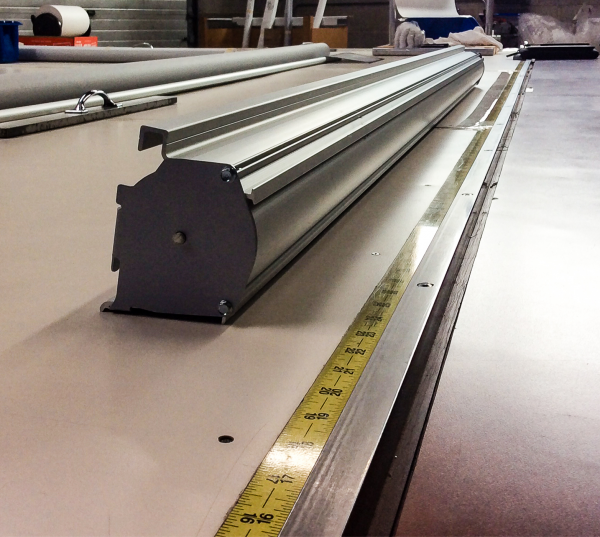









Image Credit : Chris Nurre and Bob Kearns

Project Overview
Most of us have experienced the uncomfortable fluctuations in office temperatures. Near the windows rooms are almost unbearably hot but in the centre of the building the AirCon drops temperatures to arctic setting. Cold employees experience a 10% productive decrease, about 25 lost working days a person, according to a Berkeley Lab study. AirCon consumes about five percent of all the electricity produced in the U.S. Cooler buildings are warming the planet as 100 million tons of carbon dioxide are released each year.
The Parata Solutions shade system reinvents the traditional window shade with a new housing design and attachment method. The Parata shade contains the air in between the glass and cloth to capture the air movements and utilizes air as a natural insulator. This creates another thermal barrier similar to double pane glazing systems. Sitting a consistent distance from the glass, it reduces the peak and trough energy fluctuations used to maintain comfortable environments. This increases productivity and decreases energy usage without requiring any action by the users.
Organisation
Team
Chris Nurre - product concept and design
Bob Kearns III - 3D modelling
Chris Matus - Market advice
Dick Co - Environmental design
Project Brief
Parata's shade insulates the room at the window so room temperatures remain more consistent. The patent pending housing directs the cloth near to the glass without wrinkling. This creates an insulating layer. Testing at the Illinois Institute of Technology demonstrated a 16% improvement in the insulating properties over having no shade on the window and 11% better than a traditional assembly. By containing heat build-up at the window, cooling systems work less to maintain a steady temperature.
The Parata shade housing installs with a unique adhesive solution that avoids drilling into and damaging the curtain wall of the building. Drilling in to the building can lead to moisture damage and other structural issues. Architects and building owners increasingly demand that nothing is drilled into the curtain wall but no other system on the market is designed for an adhesive attachment. The temporary nature of the adhesive also allows the shade to be treated as furniture for depreciation purposes. Tenants are empowered to make the purchasing decision because furniture items do not require permission of the building owner. The shade can be removed and reused in a new space.
Project Innovation/Need
The Parata shade solution is a patent pending design that advances both the method of installation and the housing of window shades. Even as other building materials have advanced, there have been few developments in housing and furling systems. Other shading solutions typically provide a shade cloth or element that hangs from a glazing unit and functions primarily to block direct sunlight. The unit does little or nothing to contain the heat that is generated by the sun coming through the window. This “oven effect” is created by the outward facing side of the shade cloth and the inside face of the window. The Parata shade contains the air in between the glass and cloth to capture the air movements and utilizes air as a natural insulator.
The installation method has also not advanced until now. Glass and curtainwall high rise construction have greater need for shading solutions but installing with drills damages the building efficiency, causes structural damage and voids the warranty. Parata's adhesive solution overcomes these failing, providing an attachment method in line with architects requirements.
Design Challenge
The team observed damage done to building substrate by the current shade attachment method of screwing in to the curtain wall. The building industry knows you should not screw in to curtain wall but no solutions existed in the market. A high bond tape was identified that insulates, reducing energy transfer from envelope of building to interior space. Next was the problem of shade cloth rippling. Downward loading of the aluminum tube from the weight of the shade cloth also deflects the integrity of the porous aluminum tubing, telescoping this in the form of rippling in the shade cloth material. Rapid 3D printing allowed Parata Solutions to test solutions to counter the deflection of the axis aluminum tube. Adding a horizontal intermediate allowed the cloth to relax into its natural form and unfurl in a level and plumb format. Additional value was added by qualifying the energy transfer with local academic institutions like Illinois Institute of Technology, Northwestern University and The Marmion Academy. By taking a thorough design process of deconstruction to analysis to goal driven success resulted in a solution that performs 21% better at reducing the solar heat gain coefficient than existing shades.
Sustainability
The shade system is made from 59% recycled aluminum and 95% recycled steel. The recycled materials are sourced, cut, and assembled by regional suppliers. Parata Solutions is committed to keeping our supply chain local so that the end product travels fewer miles to reach the user. This reduces the carbon footprint of the product. The product uses fabric with low chemical emissions, improving the quality of the air in which the products are used. The adhesive attachment allows the shade to be removed and reused or retro-fit into new spaces. part Solutions has recently been awarded pending B Corp status for our commitment to building a company that meets rigorous standards of social and environmental performance, accountability, and transparency. The company will be working toward full B Corp status over the next twelve months.
Product Design - Office
This award celebrates creative and innovative design for either a component or overall product. Consideration given to aspects that relate to human usage, aesthetics, selection of components and materials, and the resolution of assembly, manufacturing and the overall function.
More Details

